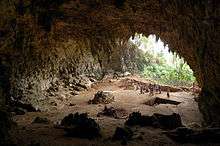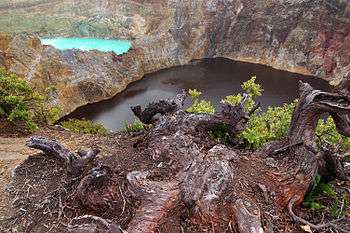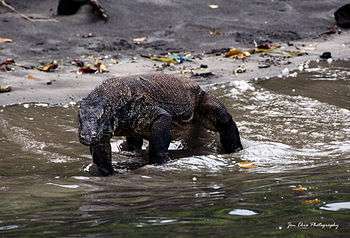Flores (Indonesia)
Flores (Portuguese for 'flowers') is an island in Nusa Tenggara, Indonesia.

Cities
- 🌍 Labuanbajo — launching point for Komodo Island and diving and snorkeling
- 🌍 Ruteng — Home to Manggarai ethnic minority interesting local villages. A cooler climate 1,100 meter above ground.
- 🌍 Bajawa — is one of the best areas in Nusa Tenggara to see indigenous architecture of the local ethnic minority Ngadha. A cooler climate 1,200 meter above ground.
- Riung — diving/snorkeling center, the second Labuan Bajo without the influx of tourists
- 🌍 Ende — lazy capital of the Island and departure point for ferries to West Timor
- Moni — launching point for trek up Mount Kelimutu
- 🌍 Maumere — diving/snorkeling center and easiest place to fly in and out of Flores
- Larantuka — port town on the eastern end of the island with a large Catholic community and Portuguese influences
Other destinations
- 🌍 Komodo National Park — home of the Komodo dragon, a very rich marine fauna and magnificent remote landscapes. The National Park includes smaller islands such as Kalong Island, Kanawa Island, and Seraya Island (see Labuhan Bajo page for more details)
- 🌍 Wae Rebo — traditional village in a spectacular mountain valley.
- 🌍 Kelimutu — the famous three-colored lakes
Understand

Flores is located east of Sumbawa and west of the Solor Archipelago (which includes Adonara, Lembata and Solor) and the Alor Archipelago. To the southeast is Timor. To the south, across the Sumba strait, is Sumba and to the north, beyond the Flores Sea, is Sulawesi.
Labuan Bajo is the most crowded by tourists due to the Komodo Island. The Portugese set their first major establishment in Larantuka. The largest town is Maumere. There are many tribes and sub-tribes in Flores, the two most well-known is Manggarai in the West and Ngadha in the Central.
Travelers who have enough by the invasion of tourists in Bali are highly recommended to check out Flores as the next destination.
Religion
Flores is almost all Catholic and represents one of the "religious borders" created by the Catholic expansion in the Pacific and the spread of Islam from the west across Indonesia. In other places in Indonesia, such as in Maluku and Sulawesi, the divide is more rigid and has been the cause of bloody sectarian clashes.
Talk
There are many languages spoken on the island of Flores, all of them belonging to the Austronesian family. In the centre of the island in the districts of Ngada and Ende there is what is variously called the Central Flores Dialect Chain or the Central Flores Linkage. Within this area there are slight linguistic differences in almost every village. At least six separate languages are identifiable. These are from west to east: Ngadha, Nage, Keo, Ende, Lio and Palu'e, which is spoken on the island with the same name of the north coast of Flores. Locals would probably also add So'a and Bajawa to this list, which anthropologists have labeled dialects of Ngadha.
Portuguese traders and missionaries came to Flores in the 16th century, mainly to Larantuka and Sikka. Their influence is still discernible in Sikka's language and culture.
Get in
By plane
There are six airports distributed along the 354 km of Flores island, the main ones being at Labuanbajo (LBJ IATA) and Maumere (MOF IATA). Both have regular services to Denpasar (Bali), Lombok, Kupang (West Timor) and various minor islands in Nusa Tenggara. Other airports include: Turelelo (Bajawa) Soa Airport (BJW IATA), Frans Sales Lega Airport in Ruteng (RTG IATA), H. Hasan Aroeboesman Airport in Ende (ENE IATA), and Gewayantana Airport in Larantuka (LKA IATA)
By boat
Pelni ships call at Labuanbajo, Maumere, Larantuka and Ende and link the island with other parts of Indonesia. Numerous other ships also serve Flores, including the ASDP ferry from Labuanbajo to Sape (Sumbawa) and the wooden ferries from Larantuka to the islands of Adonara and Lembata in the Solor archipelago. Check the Indonesian Pelni website but check with offices to be sure, and arrival and departure times are flexible.
A number of companies, most notably Perama, organise 4 day sailing trips between Lombok or Bali and Flores which take in Komodo and Rinca, with prices between Rp 1 and 2 million. Creature comforts are few, with accommodations usually consisting of a thin reed mat on planks, and safety equipment is minimal to nonexistent. A Perama boat sank in 2011, fortunately near the shore and so there were no casualties.
By bus
Overland travel is a possibility as well, although it is a long haul from most places. From Mataram (Lombok), a combined ticket including all buses and ferries costs Rp 340,000. The journey takes over 24 hours and has a buffet meal included in the price on Sumbawa. Most buses leave Mataram in the afternoon to meet the morning ferry from Sape to Labuan Bajo. Crossing Sumbawa at night they speed on the empty roads, so instead of slumbering the hours and miles away it could be a rather stressful journey. To Bima (Sumbawa), the bus is 'executive class', while the 2 hours from Bima to Sape are done in a crammed minibus. Instead of buying a combined ticket, it a viable alternative is to do the trip step-by-step (see ). This is only marginally cheaper (315K Rp), but does give increased flexibility in case something goes wrong (e.g. bus breaks down). In this case, the journey from Mataram to Labuan Bajo has three legs:
1. Bus from Mataram Terminal Mandalika to Bima. Several buses take the same route, but they all seem to depart daily at 14:30-15:00h. You can buy a ticket at an office in the bus station (ignore the touts), although this still seems to be a tour operator instead of the bus company itself. Price is 225K Rp, but there is likely some room for negotiation. The bus drives to Labuhan Lombok, then goes on the ferry to Poto Tano, Sumbawa (be sure to get back on the bus before the boat finishes docking; it will drive straight off the ferry and won't wait for you). It then continues on to Bima, stopping somewhere between 21:00-24:00h for an included buffet dinner. The bus should arrive in Bima between 3:00-6:00 in the morning.
2. Get a minibus from Bima to Sape. Foreigner prices seem to be 30K, but locals pay between 5K-10K.
3. Take the ferry from Sape to Labuan Bajo, Flores. Listed price is 60K Rp. There is only one ferry daily, which departs at 10:00h (although reports online state the schedule varies, and that there might also be a second ferry in the afternoon). The journey takes about 5-7 hours. If you're doing this entire trip in one go, you'll likely be quite tired at this point, but the boat does have a limited supply of reasonably comfortable mats for you to sleep on for an extra 25'000 Rp (just grab one and someone will come to collect money from you later).
Get around
Bemos, small vans with seats facing each other, operate linking all the main towns. It is an incredible way to see the island and the driving ensures it is an exhilarating journey if you don't mind the heat, dust and being squashed next to an old dear with a chicken. A distance that looks short on the map can still take hours in reality, so be patient and try to enjoy the journey.
For transportation between towns in Flores, your accommodation or tour agents will mention "Travel" as one of the option, which is a shared car. This is usually this is a 6-seater SUV. Sometime they would pick up travelers along the way if the route and rate are right.

See
The two most famous tourist attraction in Flores island are:
- Komodo dragons in Komodo National Park
- The crater lakes at Mount Kelimutu usually reach from Ende. The colours change on a regular basis with aqua/turquoise, green, red and chocolate brown reported. This amazing natural phenomenon is thought to be caused by chemical reactions of minerals in the lake triggered by volcano gas activity.

Do
Flores has good snorkeling and scuba diving in several locations along the north coast, most notably Komodo and Riung. However, the coral reefs of Riung are slowly being destroyed due to the destructive practice of local fishermen using dynamite and locals selling shells to visitors. The Komodo National Park is held up as a role model for other parks throughout the world, and the reefs and marine life are in nearly pristine condition.
Flores also has a growing Eco-tourism industry, where you can visit traditional villages, stay with local families and join in eco-friendly activities such as bird watching, trekking and participate in dances. Flores Eco-Tourism is one company that organises such tours.
If you receive an invitation to attend a wedding or other similar event, do not miss it. Those are the best way to learn about the Manggarai or Ngadha cultures. Ask for the norm (what to bring along, what not to do) and behave (e.g. avoid taking excessive photos during sensitive time).
Eat
Drink
Since majority of the population of Flores are non-Muslim, alcohol consumption is part of the culture here. The most popular drink is arak or sopi or moke which is made from the distilled palm sap. Unlike in Bali and Java that have a long standing bad reputation on arak contamination, Flores maintains its arak quality even though there is no label or brands.
If you come to the city Ende, be sure to try their kind of Indonesian coffee 'Kopi Ende'. It is coffee beans and ginger toasted together and brewed like normal coffee.
Stay safe
There are different hospitals (called "Rumah Sakit") and health stations (called "Puskesmas") on the island. The best hospitals are in Cancar (near Ruteng) in the western part and in Lela (near Maumere) in the eastern part of the island. If you decide to go hiking you should be aware of some dangerous snakes.
Go next
- Alor Archipelago
- West Timor and then Timor Leste (East Timor)
- Sumba
- Bali
- Lombok